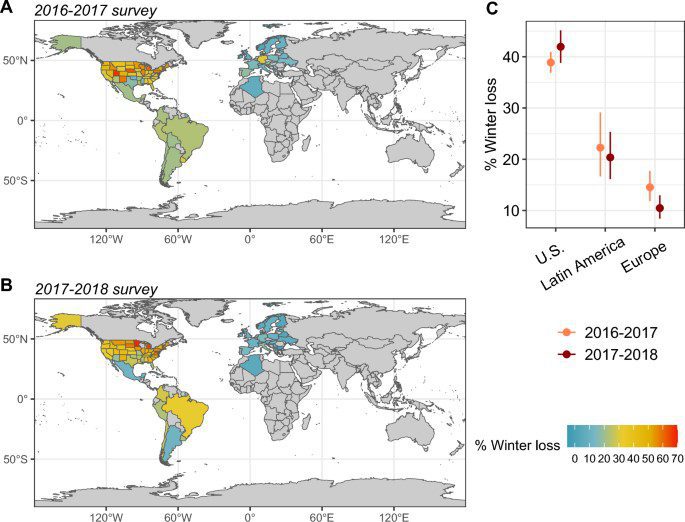Scientific Reports
First large-scale study reveals important losses of managed honey bee and stingless bee colonies in Latin America
- Fabrice Requier,
- Malena Sibaja Leyton,
- Carolina L. Morales,
- Lucas A. Garibaldi,
- Agostina Giacobino,
- Martin Pablo Porrini,
- Juan Manuel Rosso-Londoño,
- Rodrigo A. Velarde,
- Andrea Aignasse,
- Patricia Aldea-Sánchez,
- Mariana Laura Allasino,
- Daniela Arredondo,
- Carina Audisio,
- Natalia Bulacio Cagnolo,
- Marina Basualdo,
- Belén Branchiccela,
- Rafael A. Calderón,
- Loreley Castelli,
- Dayson Castilhos,
- Francisca Contreras Escareño,
- Adriana Correa-Benítez,
- Fabiana Oliveira da Silva,
- Diego Silva Garnica,
- Grecia de Groot,
- …
- Karina Antúnez
Scientific Reports volume 14, Article number: 10079 (2024)
Abstract
Over the last quarter century, increasing honey bee colony losses motivated standardized large-scale surveys of managed honey bees (Apis mellifera), particularly in Europe and the United States. Here we present the first large-scale standardized survey of colony losses of managed honey bees and stingless bees across Latin America. Overall, 1736 beekeepers and 165 meliponiculturists participated in the 2-year survey (2016–2017 and 2017–2018). On average, 30.4% of honey bee colonies and 39.6% of stingless bee colonies were lost per year across the region. Summer losses were higher than winter losses in stingless bees (30.9% and 22.2%, respectively) but not in honey bees (18.8% and 20.6%, respectively). Colony loss increased with operation size during the summer in both honey bees and stingless bees and decreased with operation size during the winter in stingless bees. Furthermore, losses differed significantly between countries and across years for both beekeepers and meliponiculturists. Overall, winter losses of honey bee colonies in Latin America (20.6%) position this region between Europe (12.5%) and the United States (40.4%). These results highlight the magnitude of bee colony losses occurring in the region and suggest difficulties in maintaining overall colony health and economic survival for beekeepers and meliponiculturists.
Figure 5
Comparison of winter colony loss of honey bees among large-scale monitoring initiatives including Latin America (the present SOLATINA initiative), the United States (the BIP initiative) and Europe (the COLOSS initiative, that also includes non-European countries such as Algeria). (A) Winter loss over the 2016–2017 survey and (B) over the 2017–2018 survey. The winter period represents October 1st to March 31st in the Northern Hemisphere and April 1st to September 30th in the Southern Hemisphere. (C) Predicted total winter loss of honey bees per large-scale monitoring initiative and year, with thick lines indicating the 95% CI (based on GLM predictions). Large-scale monitoring initiatives are ordered by decreasing loss values. The colors distinguish the two years of the data collection (2016–2017 in orange and 2017–2018 in brown).

